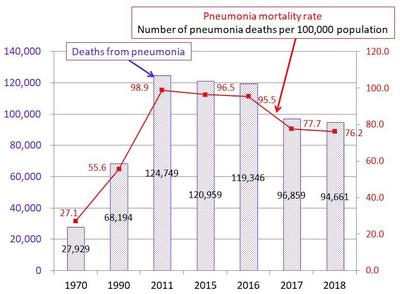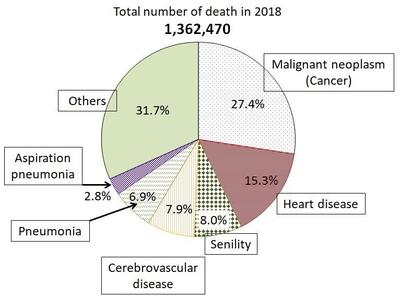Column Finance and the Social Security System 2020.06.25
【Aging, safety net and fiscal crisis in Japan】No.236: Pneumococcal vaccine for elderly people
Due to the spread of COVID-19, public interest in pneumonia is increasing. Figure 1 shows a historical trend of the number of deaths and the mortality rate of pneumonia, excluding aspiration pneumonia. The mortality rate is measured as the number of pneumonia deaths per 100,000 people, which surged from 27,929 in 1970 to 124,749 in 2011. The mortality rate also increased from 27.1 to 98.9, primarily because the number of elderly people who die of pneumococcal infection has increased.
Therefore, in October 2014, the government started a system to encourage elderly people to get the pneumococcal vaccine regularly, which is once every five years for people aged 65 or older. As a result, the number of deaths and the mortality rate of pneumonia are on the decline. However, the number of deaths from pneumonia in 2018 was 94,661, and the percentage in all deaths was still high at 6.9% (Figure 2). In order to improve this situation, it is necessary to raise the vaccination rate of elderly people who became the target of pneumococcal vaccination as they had a vaccination rate of only 35.1% in 2017 (Table 1).
Figure 1 Deaths and mortality from pneumonia
 *Please click the table image to find the original size image.
*Please click the table image to find the original size image. Source: Ministry of Health, Labor, and Welfare
Figure 2 Percentage of death causes
 *Please click the table image to find the original size image.
*Please click the table image to find the original size image. Source: Ministry of Health, Labor, and Welfare
Table 1 Rate of pneumococcal vaccination(2017 results)
 *Please click the table image to find the original size image.
*Please click the table image to find the original size image. Source: Ministry of Health, Labor, and Welfare
